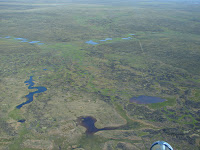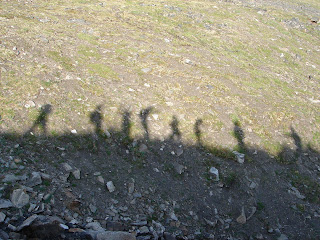 The 25th of July was Christmas. Everyone who wanted to participate put their names in a box for Secret Santa! We all made gifts out of found objects for the other person. It was pretty impressive how creative some people were! Examples of gifts included a moose attack survival kit, river dioramas, a puppy constructed out of cardboard tubes and springs, and even a sheep made from real sheep's fur! The person I was making my present for is really into puns so I did an online search for puns and collaged a 1-L square water bottle (which was really a washed out sample collection bottle) with all of the best (and worst!) puns that I found. I also added a couple of really funny cartoons. My favorite was an xkcd cartoon about the purity of sciences:
The 25th of July was Christmas. Everyone who wanted to participate put their names in a box for Secret Santa! We all made gifts out of found objects for the other person. It was pretty impressive how creative some people were! Examples of gifts included a moose attack survival kit, river dioramas, a puppy constructed out of cardboard tubes and springs, and even a sheep made from real sheep's fur! The person I was making my present for is really into puns so I did an online search for puns and collaged a 1-L square water bottle (which was really a washed out sample collection bottle) with all of the best (and worst!) puns that I found. I also added a couple of really funny cartoons. My favorite was an xkcd cartoon about the purity of sciences:I was pretty proud of how it turned out. Dan even dressed up as the grinch/santa and Scotty (one of the camp staff members) made a Christmas tree out of the midget willow branches!
 I have a feeling this week was kind of like spring/winter weekend at Smith... or rather the calm before the storm! We are about to hit crunch period in the next few weeks. i can't believe I only have a month here left ...
I have a feeling this week was kind of like spring/winter weekend at Smith... or rather the calm before the storm! We are about to hit crunch period in the next few weeks. i can't believe I only have a month here left ...~~~~~~~~~~~~~~~~~~~~~~~~~~~~~~~~~~~
Just so you all don't think that we are only partying around here, I felt the need to post about the thermokarst site where I helped Sarah measure thaw depth, soil moisture, and soil conductivity along 4 transects. Thermokarst refers to land features (commonly slumps, fractures, and other land failures) that occur due to the melting of permafrost (frozen ground). Measuring thaw depth basically requires pushing a large pole down into the tundra until it hits the permafrost. The problem is that the pole often hits rocks or gravel before it reaches the permafrost. Although the reverberation of the pole against rocks is significantly different than the pole hitting the frozen ground, it is often difficult to find points without rocks.
 So much of the permafrost had melted out at one part of the land failure caused a large cave to form. Ice was actually exposed on the back wall and the overhang was almost solely supported by roots from the tundra plants and grasses!
So much of the permafrost had melted out at one part of the land failure caused a large cave to form. Ice was actually exposed on the back wall and the overhang was almost solely supported by roots from the tundra plants and grasses!


 So much of the permafrost had melted out at one part of the land failure caused a large cave to form. Ice was actually exposed on the back wall and the overhang was almost solely supported by roots from the tundra plants and grasses!
So much of the permafrost had melted out at one part of the land failure caused a large cave to form. Ice was actually exposed on the back wall and the overhang was almost solely supported by roots from the tundra plants and grasses!











































